Is the world ready for GM animals?
- Published
The use of genetically engineered animals could revolutionise whole areas of public health and agriculture, according to advocates. But is the world ready for modified mosquitoes and GM salmon?
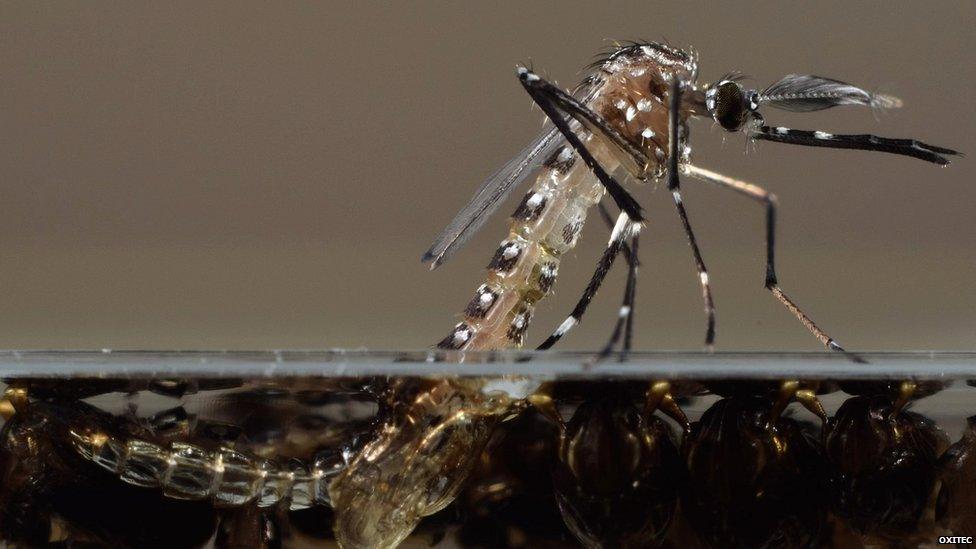
The Aedes aegypti mosquito is a principal vector for diseases such as dengue
Back in the 1950s, two American scientists came up with a revolutionary idea to eliminate a longstanding scourge of livestock farming.
A parasite known as screwworm was devastating herds in the American south, disrupting food supplies and costing hundreds of millions of dollars in annual losses.
Screwworms are the larval stage of the blowfly, and are able to bore through live flesh - killing farm animals within 10 days of infection.
Raymond Bushland and Edward Knipling broke the screwworm's life cycle without using toxic insecticides. They bred large numbers of blowflies, sterilised them with X-rays and released them into the wild. Here, the sterile males mated with native females to produce sterile offspring.
Repeated releases caused populations to crash, and over two subsequent decades, the US brought the problem under control.
A British biotech company called Oxitec, external is now pioneering a novel twist on this idea, known as the sterile insect technique (SIT). But the firm has swapped irradiation for the more precise and cost-effective toolkit of genetic modification.
Oxitec has developed a transgenic strain of the Aedes aegypti mosquito which transmits the virus responsible for dengue fever in its bite. There is currently no vaccine for dengue, which causes severe flu-like illness that can result in lethal complications. Estimates put annual cases at between 50 and 100 million worldwide, external, and the incidence is rising.
The company's patented technique involves the insertion of a lethal gene into insect embryos. The scientists rear the modified mosquitoes in a laboratory, keeping them alive by supplementing their diet with the antibiotic tetracycline.
Modified males - which don't bite people - are then released to mate with wild female mosquitoes. The males impart the lethal gene to their offspring which, lacking the dietary supplement to keep them alive, die before adulthood. Continued releases of engineered mosquitoes should cause wild populations to crash.

Dengue fever afflicts up to 100 million people worldwide each year, and can be a killer
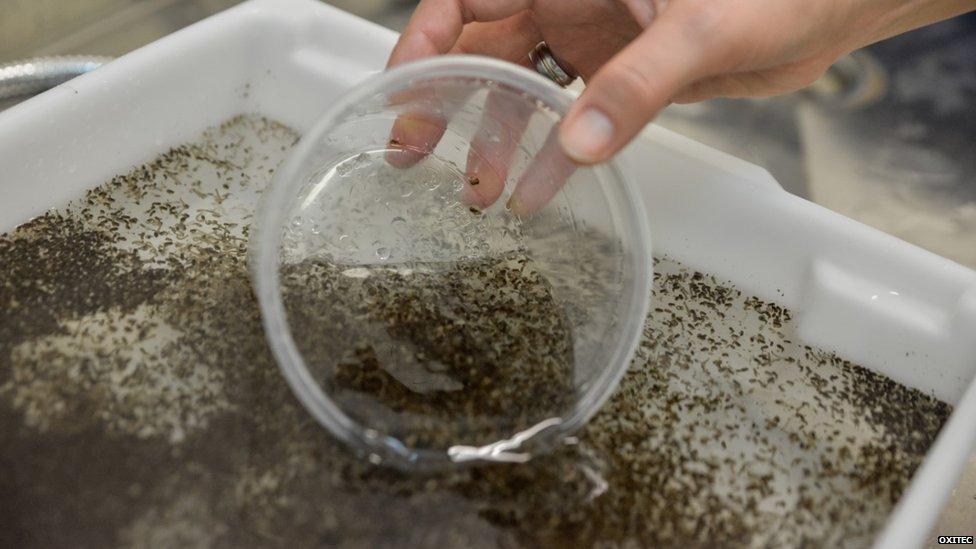
At Oxitec's production facility in Brazil, GM mosquitoes (shown here in their larval stage) are reared in preparation for release
The company has also inserted a fluorescent protein that makes the insects glow under certain light filters. This means they can be identified in the wild, allowing scientists to monitor a trial's progress.
GM animals are nothing new, of course. Transgenic mice, rats and other laboratory animals have transformed our understanding of human disease and facilitated the development of new drugs - though welfare considerations make their continued use controversial.
Goats have been genetically modified to produce human drugs, external - and even spider silk - in their milk. And glow-in-the-dark fish, external, engineered with a fluorescence gene, have been approved for sale in all US states except California.
But Oxitec's plans offer a striking vision of the future ways genetically modified animals could help tackle public health problems or offer new options to industry - including food production.
The company is also targeting agricultural pests, including the olive fly - the biggest threat to olive production worldwide.
"The core technology can be used in any insect really, as long as it employs sexual reproduction," says Hadyn Parry, Oxitec's chief executive.
But it is pursuing public health applications first. During the first outdoor trial of the dengue mosquitoes in the Cayman Islands back in 2010, external, some 3.3 million insects were released over five months. The company says the trial resulted in an 80% reduction in the Aedes aegypti population.
The method of release is straightforward: "You literally send a truck down the street, and in the back are little clear pots of male mosquitoes covered by muslin," Mr Parry told BBC News.

Outdoor releases, such as this one in Panama, have used a truck to disperse the mosquitoes
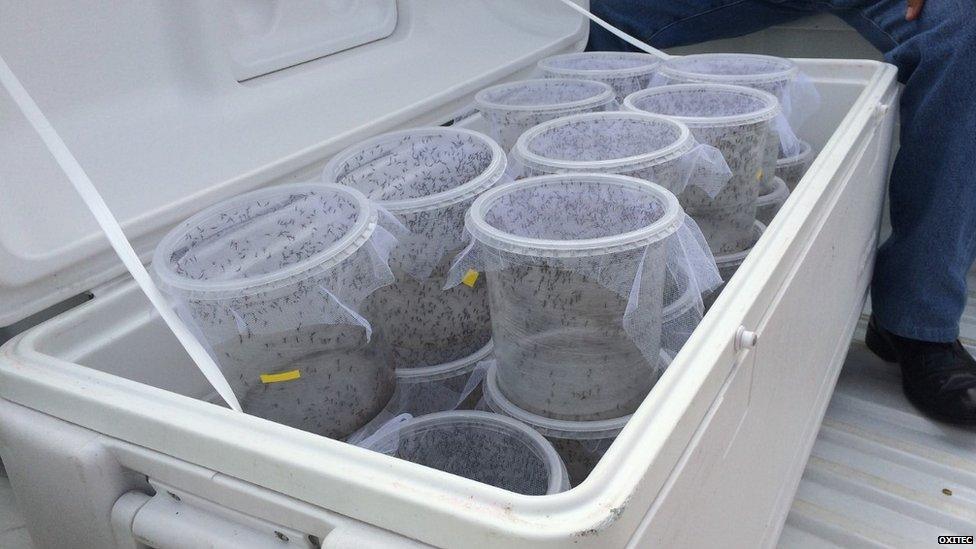
Oxitec staff shake genetically engineered mosquitoes from pots in the back of the vehicle
"Every hundred yards or so, the operator takes the muslin off and just shakes them out. Then the all-male mosquitoes seek out the females. You need to work out a grid pattern to make sure that your releases cover the town."
In Brazil, the mosquitoes have passed all regulatory hurdles and Oxitec has now built its own factory in the South American country. It employs staff to hatch and rear the modified insects, which are then sold to towns and municipalities on demand.
The company is also awaiting permission from US authorities to conduct field trials of its GM mosquitoes in the Florida Keys this year.
But the proposal sparked a petition on change.org urging regulators to prevent testing of "mutant bugs" in the popular tourist spot.
Dana Perls, food and technology policy campaigner for Friends of the Earth, external, said there had been no independent environmental impact assessment.
"The bottom line is there is inadequate regulatory oversight. There is virtually no system for monitoring, or liability relating to the releases," she told BBC News.
"It seems unnecessary; there hasn't been an outbreak of dengue in Florida since 2009, external. We need to evaluate alternative methods of dengue prevention that are less risky, more effective and more sustainable for people and the environment."
Oxitec chiefs had been expecting opposition, having observed the continuing controversy over GM crops.
But Mr Parry stresses a fundamental difference: "With GM crops, the gene is advantageous, so nature will seek to preserve the advantage. We're giving our organisms a disadvantage - the inability to reproduce."
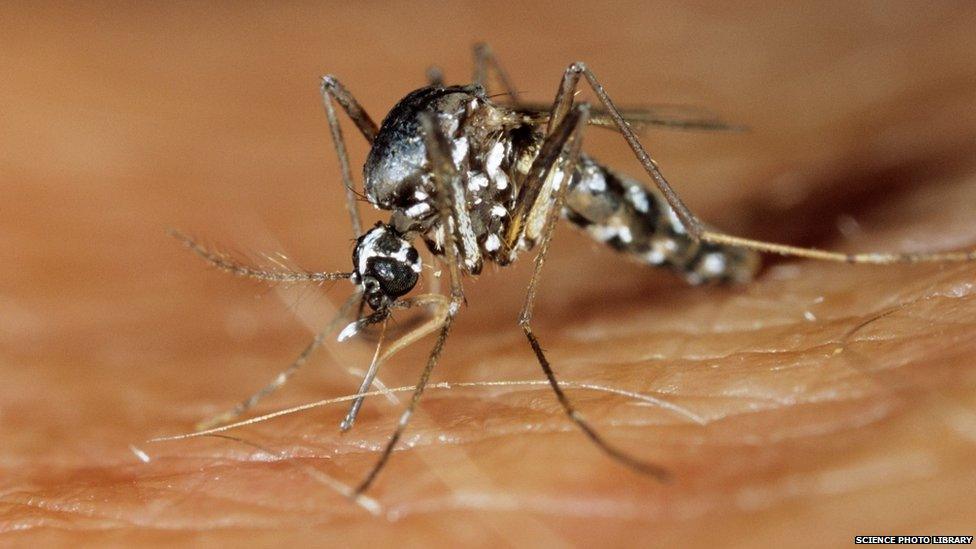
The Asian Tiger Mosquito has established itself in the Americas over the last 30 years
Dr Matthew Miller is a tropical biologist based in Panama, where Oxitec recently carried out field trials with A. aegypti. He's not opposed to GM technology, but believes programmes focused on controlling a single species can have unforeseen consequences.
While A. aegypti remains the main vector for dengue fever, another species called the Asian tiger mosquito (Aedes albopictus) has expanded across Panama over the past 30 years. Meanwhile, another mosquito-borne disease, called Chikungunya, has exploded in the Americas within the last year.
"If you are completely efficient and remove Aedes aegypti from the landscape… albopictus may very well just move in and efficiently vector both dengue and Chikungunya. So I'm not really sure what you've won," says Dr Miller, from Panama's Smithsonian Tropical Research Institute.
But Mr Parry says A. aegypti is a fundamentally more effective vector of human disease because it feeds almost exclusively on people and is found in urban areas. A. albopictus, on the other hand, will "bite anything that moves" and prefers forests.
In a recent academic study, external, Dr Miller and his co-author Jose Loaiza found that the Asian tiger mosquito used road networks to quickly disperse across Panama - literally hitch-hiking across the landscape.
"If Aedes aegypti behaves like A. albopictus, it's likely to be constantly streaming into the system [from outside]," says Dr Miller, who worries that countries could get locked into an endless cycle of GM mosquito releases.
Oxitec acknowledges that eradication isn't practical in busy, interconnected areas, but stresses that it's not offering an all-or-nothing solution. Authorities can continue using insecticides alongside its products and discontinue GM mosquito programmes if they change their minds.
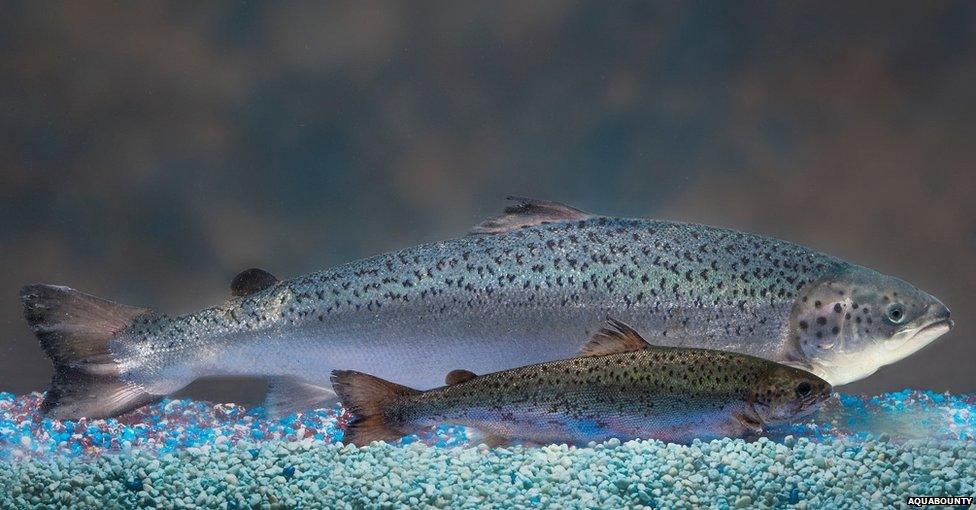
The AquaBounty salmon is seen here alongside its non-transgenic sibling
Dr Alison Van Eenennaam, from the University of California, Davis, is a world authority on genetic engineering in animals. She believes the technology holds huge potential for society, but is sceptical of its prospects in the US - particularly for applications in food production - and says investment has more or less dried up.
"We've had three approvals up to this point [in the US]: two for drugs and one for the GloFish. But from the food perspective, there's just such a well-oiled activist opposition," she told BBC News.
She says the real interest is coming from other countries, such as Argentina and Brazil: "Maybe it's appropriate that this technology moves to the developing world where the need for food is more pressing than in the well-fed Western world where you can have an ultra-conservative approach to risk and a Pollyanna-ish view of what's natural and unnatural."
Hopes for a US regulatory approval currently rest on the GM Atlantic salmon developed by AquaBounty, a company headquartered in Maynard, Massachusetts, external. If given the go-ahead by the Food and Drug Administration (FDA), it would be the first transgenic meat to make it to dinner plates anywhere in the world.
Scientists took a growth hormone regulating gene from a Pacific Chinook salmon and inserted it into an Atlantic salmon. The resulting fish grows all year round, rather than just during spring and summer. It reaches market size in 16 to 18 months, rather than three years.
Accelerated growth means shorter production cycles, resulting in a more efficient use of feed.
Ron Stotish, AquaBounty's chief executive, says this dramatically alters the economics of salmon cultivation, making it feasible to house salmon in land-based facilities closer to population centres where they are consumed, thereby reducing carbon footprints.
"The impact on global food production is potentially enormous," Dr Stotish told BBC News.
The company submitted its application to market the salmon back in 1995, but it took until 2012 for the FDA to issue a Finding of No Significant Impact, external - the last hurdle before approval. Dr Stotish is hopeful of seeing his product given the go ahead this year.
"This fish has been bred by conventional means for more than 25 years, so we know almost all that there is to know by now," he said.
"It is identical to all other Atlantic salmon: it looks the same, it tastes the same. The only thing it does different is grow faster."
But Dana Perls from FOE says: "More than 1.8 million people have submitted comments to the FDA opposing the approval. Polls show that Americans won't eat genetically engineered seafood. We've seen more than 60 US food retailers make commitments not to sell the GMO salmon.
"There's no room on our plates for genetically engineered seafood. Consumers don't want it, fishermen don't want it."
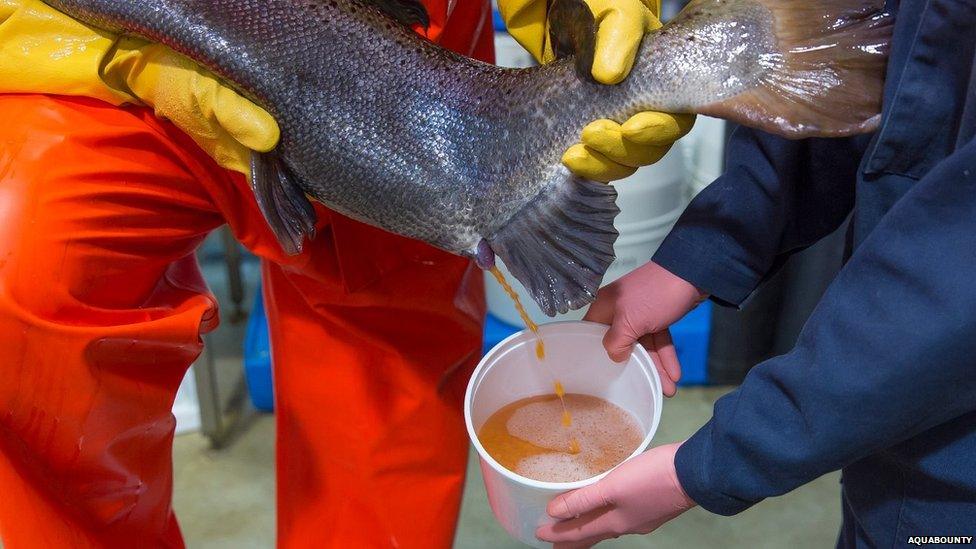
AquaBounty produces the genetically modified salmon eggs at a facility in Prince Edward Island, Canada
In November, FOE criticised the company, external over its management of a Panamanian production facility for the GM salmon. It said a decision to hand over elements of safety and security to an outside contractor raised the risk of theft or escape, which could have "irreversible" effects on ecosystems.
AquaBounty shot back with a strongly worded press release, external in which it accused campaigners of making "irrational" attacks driven by an "anti-technology ideology".
Dr Stotish feels the company has bent over backwards to address accidental releases: if any GM salmon did escape, he says, all fish have been engineered to be female and sterile - preventing them from breeding with each other and wild varieties.
Alison van Eenennaam says: "We eat fast-growing fish all the time. [The salmon] has done all its evaluation, there's no novel allergen or toxin in it, there's nothing that should be raising any red flags.
"I don't know what else they could do except raise it on the Moon."
Dr Van Eenennaam advocates a different approach for regulatory approval. Instead of classifying a product according to whether genetic engineering has been used, she says regulators should look at the outcome of the process alone - the animal's "phenotype". This is partly because the emergence of precision genome editing will soon make it impossible to tell lab-modified animals from non-engineered ones.
Ron Stotish believes the potential benefits far outweigh any unforeseeable consequences: "We can respect people's views, but… if it's a minority trying to make the decision for everyone else, I think that's a big issue."
In future, marine animals could be engineered with resistance to some of the diseases that plague farmed seafood. This, he says, "would have a huge impact on the economics and the ability to produce food safely".
In the longer term, Oxitec has designs on malaria - a leading cause of childhood death worldwide. But this disease, spread by the Anopheles mosquito, presents a tougher challenge.
"With Anopheles, you've got several species. If you go to Mumbai, for example, you find that pretty much all the urban malaria is from something called Anopheles stephensi," says Hadyn Parry.
"But go to somewhere in Africa and you'll find four or five species spreading malaria, so you'd probably want to tackle all of them at the same time. It's more tricky technically.
"But in terms of having another tool in the toolbox, malaria's definitely where we want to be in due course."
Follow Paul on Twitter, external.